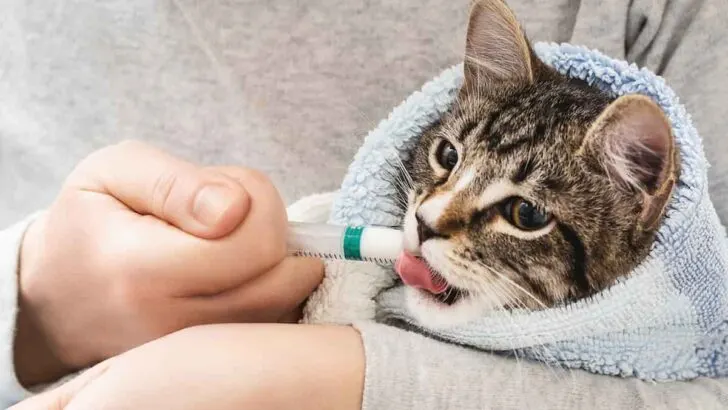Feeding a paralyzed cat can be a challenging task for pet owners. Paralyzed cats face difficulties in movement, including the inability to eat and drink normally. This can lead to malnourishment and dehydration as they struggle to perform these functions. It is essential for pet owners to understand the best methods to assist these felines in maintaining their health and well-being through proper feeding techniques.
To feed a paralyzed cat is suffering from oral dysphagia, placing a small ball of food at the back of their throat and helping them to swallow may be necessary. Alternatively, if they’re dealing with pharyngeal or cricopharyngeal dysphagia, you can try elevating their head and neck while they eat to aid in swallowing.
There are specific considerations to take into account when feeding a paralyzed cat, as their limitations can lead to further complications if not addressed correctly. By making modifications to their feeding routine and environment, pet owners can greatly improve the quality of life for their paralyzed cats.

Understanding Paralysis in Cats
Paralysis in cats is a result of disruptions to the nervous system, which encompasses the brain, spinal cord and nerves. This affects their ability to perform movements such as walking, leaping and eating; essentially restricting them from living life normally.
Causes of Paralysis
There are many explanations why a cat could become paralyzed, and one of them is a slipped disc. This happens when the cushioning between their vertebrae compresses against their spinal cord, leading to an interruption in motor ability.
Laryngeal paralysis, another plausible reason for immobility, is an upper-airway dysfunction affecting the cartilages of the larynx. These cartilages are responsible for expanding and contracting during both breathing and voicing.

Signs and Symptoms
Paralysis in cats may present as either partial or complete immobility of one or more limbs. Some common signs and symptoms of a paralyzed cat include:
- Inability to move their legs or weakness in the legs
- Dragging their rear half while attempting to walk with the front legs
- Loss of or reduced reflexes in the affected limbs
- Changes in vocalization, such as a quieter or altered meow
- Difficulty swallowing or breathing, especially in cases related to laryngeal paralysis
It is imperative to reach out to a veterinarian if you detect any of these indicators in your cat. With their expertise, they can accurately diagnose the situation and advise on the most suitable course of action for assisting your cat regain movement and enhance its quality of life.
Feeding Techniques and Tips For Paralyzed Cats
Choosing the Right Food
When feeding a paralyzed cat, selecting a suitable and nutritious diet is crucial. Look for high-quality, easily digestible food which can provide essential nutrients to support their overall health. Keep in mind any dietary restrictions or allergies your cat may have.

Assisted Feeding
If your paralyzed feline is unable to feed itself, then you may need to provide assistance. Syringe feeding is a popular technique for cats that are unable to eat unaided. Be sure to use 10cc syringes for kittens or small felines and 60cc syringes for bigger cats.
When giving them food with the syringe, go slowly and carefully so they can swallow without any risk of choking.
If your cat is paralyzed, it may require long-term assisted feeding. Your veterinarian can insert a gastrostomy tube for continuous nutrition support that necessitates the animal being put under general anesthesia. The tube will remain in place for extended periods of time – maybe weeks or months – depending on the situation.
Creating a Comfortable Feeding Environment
As PetPremium emphasizes, a paralyzed cat should be repeatedly shifted sides while feeding to prevent sores. Furthermore, splurging on an orthopedic bed would grant additional support and cushioning during their meal times.
Keep your feline companion comfortable in this way for them to receive the nourishment they need without discomfort.
Also, consider providing your cat with numerous, small meals throughout the day to make sure they are nourished. Additionally, be certain that your furry friend has access to ample fresh air – take them outside in a secure and comfortable container while being conscious of the weather conditions.
Watching for Swallowing Difficulties
Paralyzed cats may experience difficulties swallowing their food. Ensure you monitor your cat closely during meal times to identify any struggles with swallowing. Pay close attention to their facial expressions, drooling, coughing, or discomfort.
To ease the feeding process, consider offering softer, wet foods or using a blender to create a puree. This can help your cat consume the necessary nutrients with less effort.

Preventing Aspiration
Paralysis in cats can lead to a potentially fatal problem called aspiration; when food or liquids are inhaled into the lungs. To protect your pet, you must maintain proper body positioning while they eat and drink. Place a rolled towel under their chest for support, keep their head elevated, and ensure that the neck is straight during mealtime.
Doing this will help reduce any risk of aspiration significantly.
Feeding your cat smaller, more frequent portions throughout the day can also reduce the risk of aspiration. Lastly, consider seeking professional guidance from your veterinarian to evaluate and effectively manage any swallowing or aspiration concerns.

My name is James, and welcome to FAQCats!
Along with our team of cat owners, expert pet enthusiasts, and pet professionals, we aim to write engaging helpful, engaging content about cats. At FAQCats we strive to provide content that’s accurate and fun to read. Our team writes about everything related to cats; even the most complex of topics. Through extensive research and caring for our own fur-pals, we’re able to provide something cat owners worldwide will love. Have a look around, and leave us feedback anytime!

